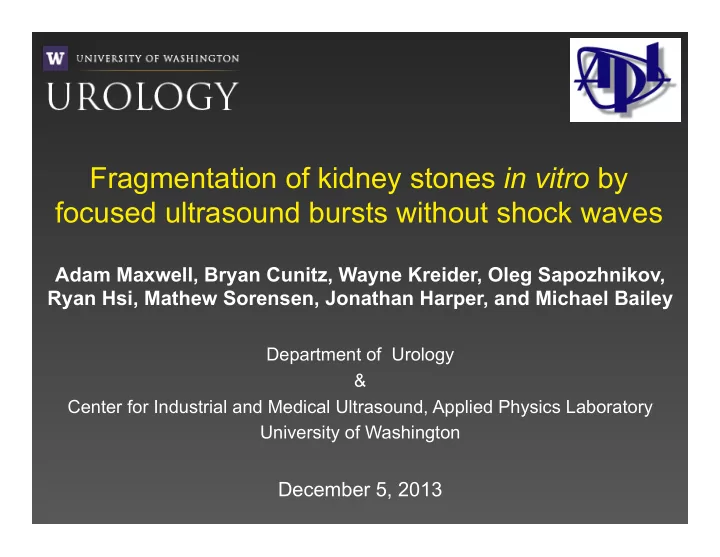

Fragmentation of kidney stones in vitro by focused ultrasound bursts without shock waves Adam Maxwell, Bryan Cunitz, Wayne Kreider, Oleg Sapozhnikov, Ryan Hsi, Mathew Sorensen, Jonathan Harper, and Michael Bailey Department of Urology & Center for Industrial and Medical Ultrasound, Applied Physics Laboratory University of Washington December 5, 2013
Shock Wave Lithotripsy • Stone-free rates for shock wave lithotripsy (SWL) have not improved with newer-generation machines 1 . SWL ¡Shock ¡Wave ¡ • Variations of shock wave output: • Focal width • Shock amplitude • Method of shock generation • More invasive techniques such as ureteroscopy 2 are gaining clinical preference 1 Lingeman JE. J Urol 2004;172:1774. 2 Matlaga, BR J Urol 2009; 181 :152-2156.
SWL Mechanisms Sapozhnikov et al 2007 • Previous studies identified mechanisms of stone fracture 1,2 : • Dynamic Squeezing/Shear • Cavitation • Cavitation is a primary cause of tissue injury. 1 Sapozhnikov et al. J Acoust Soc Am 2007:121;1190-1202 2 Zhu et al. Ultrasound Med Biol 2002;28:661-671
Objective • Hypothesis: Fracture of stones can be effectively achieved by applying ultrasound bursts without shock waves: • Broadly focused ultrasound bursts • Sinusoidal ring-down instead of negative tail to minimize cavitation SWL Shock Wave Ultrasound Sinusoidal Burst • Experiment: Determine the exposures needed to fragment stones with burst waves in vitro.
Experiment Cylinder Begostone Model 1 : Similar acoustic properties to COM 10 ¡-‑12 ¡mm ¡ Tensile Strength: ~3.5 MPa ● COM Tensile Strength: 3.1 – 5.2 MPa ● 6 ¡mm ¡ Natural Stones: 5-10 mm uric acid, struvite, calcium oxalate monohydrate (COM), and ● cystine Submerged in water ≥ 1 week ● 1 Liu Y and Zhong P. J Acoust Soc Am 2002:112;1265
Experiment 170 kHz Transducer Ultrasound System: • 170-kHz focused US transducer • 8.4 cm aperture • -6 dB beamwidth: 31 x 8 mm • High voltage RF amplifier Focal Pressure Waveform Acoustic Output: • Focal pressure ampl. ≤ 6.5 MPa • PRF: 200 Hz • Burst Length: 10 cycles
Experiment RF Amplifier Stone on Membrane Degassed Stone Water Bath 5 Fragment Basket Transducer
Artificial Stones US ¡ 1 cm • Stones fracture and fragments separate from stone surface proximal to the transducer. • Time to comminution at f = 170 kHz, p a = 6.5 MPa: 9.7 ± 2.8 minutes ( n =12)
Artificial Stones Pressure amplitude to initiate fracture at 170 kHz in 5 minutes: p a ≥ 2.8 MPa n ¡ = ¡3 ¡per ¡ p a ¡
Natural Stones Stone comminution achieved in all natural stone types treated at f = 170 kHz, p a = 6.5 MPa Uric Acid Struvite COM Cystine 1 cm 1 cm
Natural Stones • Comminution time varied dramatically with stone composition: 4 sec – 21 min ( n =3 each type) Struvite Stone Cystine Stone
Natural Stones • Comminution time varied dramatically with stone composition: 4 sec – 21 min ( n =3 each type) • Estimated comminution rate: mean 12 ~ 520 mm 3 /min Uric Bego Struvite COM Cystine Acid Stone
Fragment Size • Stone fragments photographed / sieved to obtain size distribution Sieved fragment distribution Cystine Bego Uric Struvite COM Cystine Stone Acid COM
Fragment Size • Stone fragments photographed / sieved to obtain size distribution Maximum Fragment Size Cystine Bego Uric Struvite COM Cystine Stone Acid COM
Fragment Size • Artificial stones treated at different ultrasound frequencies • p a = 6.5 MPa • Focal width ≥ Stone width 170 kHz 285 kHz 800 kHz 1 cm
Fragment Size Maximum fragment size ∝ f -1 1 cm 170 kHz ! = 0. 47 ¡/' ( ()* ) ,, ¡ 285 kHz 800 kHz
Conclusions • Focused ultrasound bursts without shock waves can fragment natural and artificial calculi. • Comminution can be achieved over time frame similar to SWL and possibly faster for certain stone types. • Fragment sizes are consistent and may be controlled by selection of ultrasound frequency.
Acknowledgments • Jim McAteer and Jim Williams at IUPUI for providing stones • NIH T32 DK007779-11A1 - Multidisciplinary Training Program in Benign Urology • NIH R01 EB007643, P01 DK043881, R01 DK092197, NSBRI NASA NCC 9-58
Recommend
More recommend